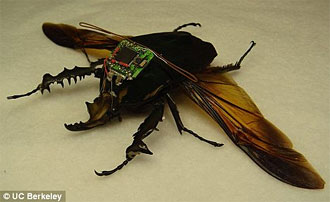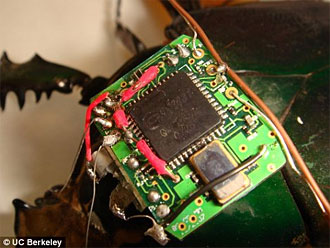
|  |  |  Technology News | October 2009 Technology News | October 2009  
U.S. Military Create Live Remote-Controlled Beetles to Bug Conversations
 Daily Mail UK Daily Mail UK
go to original
October 20, 2009


| | Researchers at UC Berkeley have implanted surveillance equipment into beetles that allows them to control where they fly. | 
| | Researchers suggest the remote-controlled beetles could serve as couriers to inaccessible places. |  |
Spies may soon be bugging conversations using actual insects, thanks to research funded by the US military.

The US Defense Advanced Research Projects Agency has spent years developing a whole host of cyborg critters, in the hopes of creating the ultimate 'fly on the wall'.

Now a team of researchers led by Hirotaka Sato have created cyborg beetles which are guided wirelessly via a laptop.

Using implants, they worked out how to control a beetle's take-off, flight and landing by stimulating the brain to work the wings.

They controlled turns through stimulating the basilar muscles on one side or the other to make the wings on that side flap harder.

The embedded system uses nerve and muscle stimulators, a microbattery and a microcontroller with transceiver.

They were implanted in the beetles when they were at the pupal stage.

Three types of large beetles from Cameroon were used in the experiments at the University of California in Berkeley. The smallest was 2cm long, while the largest was 20cm.

According to Professor Noel Sharkey, an international expert on artificial intelligence and robotics from Sheffield University, there have been attempts in the past to control insects such as cockroaches, but this is the first time the flight of insects has been controlled remotely.

Professor Sharkey questioned the ultimate military application of remotely controlled beetles as you would also need to implant a GPS transmitter and a camera too.

This would be too heavy for even the largest beetle to carry.

The Berkeley researchers suggested the 'cyborg' beetles - part beetle, part machine - could serve as models for micro air vehicles.

Sato and colleagues also said the beetles could serve as couriers to inaccessible locations. The Berkeley team is also experimenting on dragonflies, flies and moths because of their 'unmatched flight capabilities'.

DARPA's ultimate aim is to create cyborg insects that can fly more than 300ft to their target and then stay put until commanded to buzz off again.
|

 |
|  |



